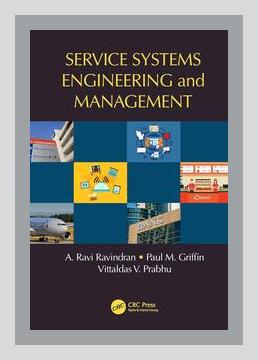Operations and Supply Chain ManagementService Operations
Introduction
A. Ravi Ravindran’s book, “Service Systems Engineering and Management,” is a comprehensive text that delves into the intricacies of designing, managing, and optimizing service systems. It services a wide range of industries by offering a blend of theoretical knowledge and practical applications. This summary breaks down key takeaways and actionable insights from the book into structured sections, maximizing the variety of points and examples provided.
1. Understanding Service Systems
Major Point: Service systems are complex arrangements that involve various stakeholders, technologies, and processes aimed at delivering value.
- Action: Conduct a system mapping of your own service operations. Identify and categorize all stakeholders, resources, and processes involved.
Example: In the book, Ravindran offers the case of a healthcare system where patients, providers, insurers, and regulatory bodies interact through a series of processes like appointment scheduling, treatment, insurance claims, and regulatory compliance.
- Action: Use tools like flowcharts and network diagrams to map out these processes, ensuring an understanding of how different elements interact in your specific context.
2. Service Design and Development
Major Point: Effective service design incorporates customer needs, business goals, and technological capabilities.
- Action: Implement robust customer feedback mechanisms through surveys and focus groups to understand service expectations.
Example: Ravindran discusses the redesign of a banking service, emphasizing the integration of online banking platforms to meet the convenience needs of modern customers.
- Action: After gathering feedback, employ design thinking methodologies to prototype and test new service approaches before full-scale implementation.
3. Service Quality and Performance Metrics
Major Point: Quality and performance metrics are crucial for managing and improving service systems.
- Action: Establish key performance indicators (KPIs) specific to your service offerings, such as customer satisfaction scores, service delivery times, and error rates.
Example: The book outlines how a telecommunication company uses Net Promoter Scores (NPS) and first-call resolution rates to gauge service quality.
- Action: Regularly analyze these KPIs, adjusting processes and training to improve performance metrics continually.
4. Technology in Service Systems
Major Point: Technological advancements play a pivotal role in enhancing service delivery and efficiency.
- Action: Invest in state-of-the-art technologies relevant to your industry, such as Customer Relationship Management (CRM) systems, automation tools, and data analytics platforms.
Example: Ravindran illustrates the use of predictive analytics in a retail setting to optimize inventory management and customer personalization efforts.
- Action: Integrate these technologies into your workflow, training staff to use them effectively and leveraging data-driven insights to make informed decisions.
5. Workforce Management
Major Point: A skilled and motivated workforce is essential for successful service operations.
- Action: Develop comprehensive training programs that equip employees with the necessary skills and knowledge.
Example: The book describes the training initiatives of a hotel chain that emphasizes soft skills and customer service excellence.
- Action: Implement regular training and development opportunities, fostering a culture of continuous improvement and employee engagement.
6. Supply Chain and Logistics in Services
Major Point: Efficient supply chain and logistics are vital for service delivery, especially in industries like healthcare and retail.
- Action: Optimize supply chain operations through just-in-time (JIT) inventory systems and robust logistics planning.
Example: Ravindran discusses a hospital’s strategy to partner with suppliers for timely delivery of medical supplies, reducing inventory costs and preventing stockouts.
- Action: Use supply chain management software to streamline operations, ensuring timely delivery of goods and services.
7. Service Level Management
Major Point: Managing service levels involves setting clear expectations and ensuring consistent delivery.
- Action: Define and communicate service level agreements (SLAs) with customers outlining the scope, quality, and timelines of service.
Example: The book cites an IT support service that uses SLAs to guarantee response and resolution times for technical issues.
- Action: Monitor compliance with SLAs and use deviations as opportunities for process refinement and better resource allocation.
Conclusion
“Service Systems Engineering and Management” by A. Ravi Ravindran provides a highly practical approach to understanding and improving service operations. By breaking down service systems into key components such as system mapping, design, quality metrics, technology, workforce management, supply chain, and service level management, Ravindran offers actionable insights that service managers can implement to enhance efficiency and customer satisfaction. The numerous real-world examples not only illustrate theoretical points but also provide concrete strategies that readers can adapt to their own service environments.
